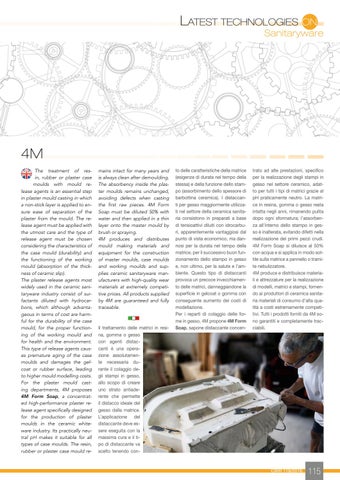Latest technologies on
Sanitaryware
4M The treatment of resin, rubber or plaster case moulds with mould release agents is an essential step in plaster mould casting in which a non-stick layer is applied to ensure ease of separation of the plaster from the mould. The release agent must be applied with the utmost care and the type of release agent must be chosen considering the characteristics of the case mould (durability) and the functioning of the working mould (absorption of the thickness of ceramic slip). The plaster release agents most widely used in the ceramic sanitaryware industry consist of surfactants diluted with hydrocarbons, which although advantageous in terms of cost are harmful for the durability of the case mould, for the proper functioning of the working mould and for health and the environment. This type of release agents causes premature aging of the case moulds and damages the gelcoat or rubber surface, leading to higher mould modelling costs. For the plaster mould casting departments, 4M proposes 4M Form Soap, a concentrated high-performance plaster release agent specifically designed for the production of plaster moulds in the ceramic whiteware industry. Its practically neutral pH makes it suitable for all types of case moulds. The resin, rubber or plaster case mould re-
mains intact for many years and is always clean after demoulding. The absorbency inside the plaster moulds remains unchanged, avoiding defects when casting the first raw pieces. 4M Form Soap must be diluted 50% with water and then applied in a thin layer onto the master mould by brush or spraying. 4M produces and distributes mould making materials and equipment for the construction of master moulds, case moulds and working moulds and supplies ceramic sanitaryware manufacturers with high-quality wear materials at extremely competitive prices. All products supplied by 4M are guaranteed and fully traceable. ■ ■ Il trattamento delle matrici in resina, gomma o gesso con agenti distaccanti è una operazione assolutamente necessaria durante il colaggio degli stampi in gesso, allo scopo di creare uno strato antiaderente che permette il distacco ideale del gesso dalla matrice. L’applicazione del distaccante deve essere eseguita con la massima cura e il tipo di distaccante va scelto tenendo con-
to delle caratteristiche della matrice (esigenze di durata nel tempo della stessa) e della funzione dello stampo (assorbimento dello spessore di barbottina ceramica). I distaccanti per gesso maggiormente utilizzati nel settore della ceramica sanitaria consistono in preparati a base di tensioattivi diluiti con idrocarburi, apparentemente vantaggiosi dal punto di vista economico, ma dannosi per la durata nel tempo della matrice, per il successivo buon funzionamento dello stampo in gesso e, non ultimo, per la salute e l’ambiente. Questo tipo di distaccanti provoca un precoce invecchiamento delle matrici, danneggiandone la superficie in gelcoat o gomma con conseguente aumento dei costi di modellazione. Per i reparti di colaggio delle forme in gesso, 4M propone 4M Form Soap, sapone distaccante concen-
trato ad alte prestazioni, specifico per la realizzazione degli stampi in gesso nel settore ceramico, adatto per tutti i tipi di matrici grazie al pH praticamente neutro. La matrice in resina, gomma o gesso resta intatta negli anni, rimanendo pulita dopo ogni sformatura; l’assorbenza all’interno dello stampo in gesso è inalterata, evitando difetti nella realizzazione dei primi pezzi crudi. 4M Form Soap si diluisce al 50% con acqua e si applica in modo sottile sulla matrice a pennello o tramite nebulizzatore. 4M produce e distribuisce materiali e attrezzature per la realizzazione di modelli, matrici e stampi, fornendo ai produttori di ceramica sanitaria materiali di consumo d’alta qualità a costi estremamente competitivi. Tutti i prodotti forniti da 4M sono garantiti e completamente tracciabili.
CWR 119/2016
115
